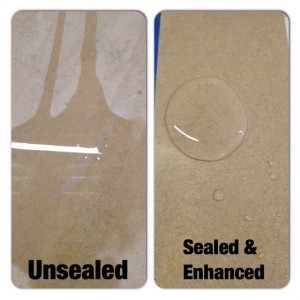Last week I shared with you my amazing trip to the Red Rocks Park and Amphitheatre. That was one amazing trip I had to Denver, Colorado!
This week, I want to discuss the care and maintenance of Sandstone countertops and floors.
Sandstone is a sedimentary rock and ranges in color from red, brown, tan, yellow, gray, pink, white and black. Sandstone is a soft and porous material, which is why care and maintenance are so important.
First things first: seal your sandstone surfaces on an annual basis.
We recommend an impregnator sealer, meaning the sealer goes into the pores of the stone and repels non-acid liquids such as water, tea, grease and oil. Sealing helps the cleaning process as well. We recommend sealing with either Seal & Go® S (solvent-based sealer) or Seal & Go® W (water-based sealer).
Please keep in mind that sealing does not prevent acid etching.
If you want to enhance the color of the sandstone (without adding any shine), you can also seal the stone with Seal & Go® Enhancer S. This product is a solvent-based sealer that gives the “wet look” and brings out the natural colors of the stone.
Make sure you are regularly cleaning your sandstone surfaces with neutral cleaners such as Lavenet or Lavenet Green. Cleaning with harsh chemical and acids may burn (etch) the surface of the stone.
Sandstone surfaces may need to be re-honed or re-polished after some time. I went to a home last year that had gorgeous sandstone kitchen countertops. The sandstone tops had reacted to acids (the typical glass ring marks and small etch marks were visible on the island and countertops). We cleaned, honed, and sealed the sandstone countertops and they were as good as new!
Sandstone is an interesting and beautiful alternative if you are looking for a unique stone for your countertops and floors.



1 Response
1 Pingback
[…] (Want more information about Sandstone? Click here.) […]